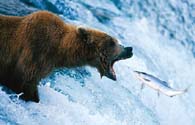The first documented case of grizzly-polar bear in wild
A DNA test has confirmed what zoologists, big-game hunters and aboriginal trackers in the far northern reaches of Canada have imagined for years: the first documented case of a grizzly-polar hybrid bear roaming in the wilds.

Roger Kuptana, an Inuit tracker from the Northwest Territories, suspected the American hunter he was guiding had shot a hybrid bear last month after noticing its white fur had brown patches and it had the long claws and slightly humped back of a grizzly.
Territorial officials seized the creature's body and a DNA test from Wildlife Genetics International, a lab in British Columbia, has confirmed that the hybrid was born of a polar mother and grizzly father.
"It's something we've all known was theoretically possible because their habitats overlap a little bit and their breeding seasons overlap a little bit," said Ian Stirling, a polar bear biologist with the Canadian Wildlife Service in Edmonton. "It's the first time it's known to have happened in the wild," reports AP.
According to CBC News, s cientists with the territory's Department of Environment and Natural Resources compared the animal's genetic makeup with samples taken from polar bears in the area and with DNA previously collected from grizzly bears along the coast to the south.
They concluded that the bear shot by Jim Martell was indeed a rare hybrid of the two types of bear. Officials say it could be the first recorded polar-grizzly bear hybrid found in the wild.
Martell, a sport hunter from the United States, was on a guided hunt when he shot the bear on April 16 near Nelson Head on southern Banks Island.
"It's a total surprise," said Roger Kuptana, Martell's guide.
He said the relationship between polar and grizzly bears is usually more adversarial.
"It’s very interesting," said Ian Stirling, Canada’s leading polar bear biologist. Some in his office have begun floating the name "nanulak," combining the Inuit names for polar bear - nanuk - and grizzly - aklak.
In tiny Sachs Harbour, where Mr. Martell’s guide Roger Kuptana lives, the going name is "Half-Breed" - and the bear is the talk of the town.
"Myself, I don’t even know what to call it," said Mr. Kuptana, who has hunted bears for 40 years. "The elders and biologists have never heard of polar bears and grizzlies mating in the wild, although it’s been known to happen in zoos."
What’s clear is that the union that produced the bear was more than a chance encounter on the sea ice, a frozen one-night stand. Female polar bears and grizzlies only become fertile after repeated mating - and the animals usually spend many days courting before parting ways again, informs National post.
O.Ch.
Subscribe to Pravda.Ru Telegram channel, Facebook, RSS!


